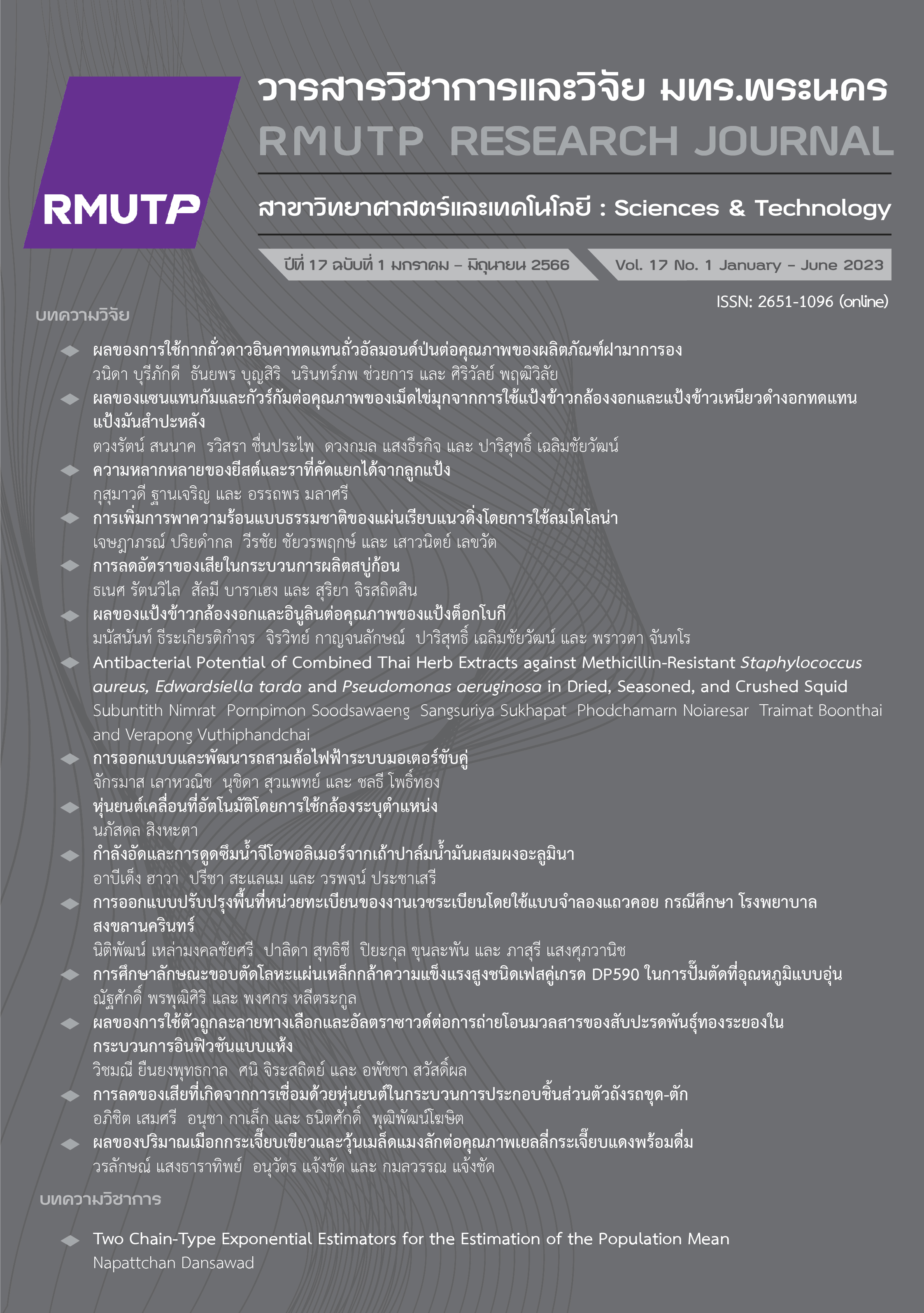The Sheared Edges Characterization of High Strength Steel Sheet Metal DP590 in Warm Blanking Process
Main Article Content
Abstract
This research aims to study the effect of metal sheets temperature and die-cutting clearance on the cutting edge quality of the finished product by the blanking operation of AHSS Dual Phase steel DP590 sheets. The shearing tests were carried out on an in blanking die by 3 size of punch–die clearance. Before the blanking test, the sheet metal is heated in an electric furnace at 4 temperature levels. To analyze finished product cutting edge quality ware consider the examined results by the optical microscopy and scanning electron microscope. The strain hardening behavior on the cutting edge was evaluated and analyzed with the micro-hardness tested results by a Vickers hardness tester. The experiment results showed that the sheet metal shearing at room temperature resulted in a high fracture region on the cutting edge. The beginning of micro-cracks occurs in the early stages of press blanking and is larger as increased of the punch and die clearance. However, the height of the fracture region tends to decrease as the sheet metal temperature increases and the die clearance decreases. In the examination results of the fracture surface characteristics and micro-hardness values, it was found that when the sheet metal temperature increased, the fracture surface had the appearance of ductile fracture because the material had a low strain hardening index. The results of this research can be applied to determine the optimum conditions for sheet metal blanking of high-strength steel sheets. That is determined by the relationship between sheet metal temperature and die clearance, which directly affects the quality of the finished cutting edge.
Article Details

This work is licensed under a Creative Commons Attribution-NonCommercial-NoDerivatives 4.0 International License.
ลิขสิทธ์ ของมหาวิทยาลัยเทคโนโลยีราชมงคลพระนครReferences
A. Konieczny and T. Henderson, “On Formability Limitations in Stamping Involving Sheared Edge Stretching,” SAE Tech, 2007.
S. F. Golovashchenko, “Quality of Trimming and its Effect on Stretch Flanging of Automotive Panels,” Journal of Materials Engineering and Performance, vol. 17, pp. 316-325, 2008.
Z. Mingqing, C. L. Yixian, L. Xiaochuan and C. Zhaoheng, “Numerical forming limit prediction for the optimisation of initial blank shape in hot stamping of AA7075,” International Journal of Lightweight Materials and Manufacture, vol. 4, pp. 269-280, 2021.
F. Sergey, N. Wang and L. Quochung, “Trimming and sheared edge stretchability of automotive 6xxx aluminum alloys,” Journal of Materials Processing Tech, vol. 264, pp. 64-75, 2019.
S. Golovashchenko, W. Zhou, S. Nasheralahkami and N. Wang, “Trimming and Sheared Edge Stretchability of Light Weight Sheet Metal Blanks,” Procedia Engineering, vol. 207, pp. 1552-1557, 2017.
M Bolin, Z. G. Liu, Z. Jiang, X. Wu, K. Diao and M. Wa, “Prediction of forming limit in DP590 steel sheet forming: An extendedfracture criterion,” Materials and Design, vol. 96, pp. 401-408, 2016.
J. H. Kim, J. H. Sung, K. Piao and R. H. Wagoner, “The shear fracture of dual-phase steel,” International Journal of Plasticity, vol. 27, no. 1, pp. 1658-1676, 2011.
L. Pan, J. Xiong, Z. Zuo, W. Tan, J. Wang and W. Yu, “Study of the stretch-flangeability improvement of dual phase steel,” Procedia Manufacturing, vol. 50, pp. 761-764, 2020.
B. L. Ennis, C. Bos, M. P. Aarnts, P. D. Lee and E. Jimenez-Melero, “Work hardening behaviour in banded dual phase steel structures with improved formability,” Materials Science and Engineering: A, vol. 713, pp. 278-286, 2018.
D. Parkes, D. Westerbaan, S.S. Nayak, Y. Zhou, F. Goodwin, S. Bhole and D.L. Chen, “Tensile properties of fiber laser welded joints of high strength low alloy and dual-phase steels at warm and low temperatures,” Materials and Design, vol. 56, pp. 193–199, 2014.
G. Nürnberg, X. Jing, D. Scherer, K. Ersoy-Nürnberg, R. Golle, J. Bohlen, L. Fuskova, D. Letzig and H. Hoffmann, “Improving the sheared edge in the blanking of commercial AZ31 sheet through texture modification,” Journal of Material Processing Technology, vol. 211, pp. 2022–2031, 2011.
L. D. Scintilla and L. Tricarico, “Experimental investigation on fiber and CO2 inert gas fusion cutting of AZ31 magnesium alloy sheets,” Optics & Laser Technology, vol. 46, pp. 42–52, 2013.
Z. Tekiner, M. Nalbant and H. Gürün, “An experimental study for the effect of different clearances on burr, smooth-sheared and blanking force on aluminium sheet metal,” Materials and Design, vol. 27, pp. 1134–1138, 2006.
A. Mackensen, M. Golle, R. Golle and H. Hoffmann, “Experimental investigation of the cutting force reduction during the blanking operation of AHSS sheet materials,” CIRP Annals, vol. 59, pp. 283-286, 2010.
K. Mori, S. Saito and S. Maki, “Warm and hot punching of ultra high strength steel sheet,” CIRP Annals, vol. 57, pp. 321–324, 2008.
P. Fazily, J. Yu and C. W. Lee, “Finite Element Analysis of Blanking Operation of Magnesium Alloy (AZ31) Sheet Using Ductile Fracture Criteria and Its Experimental Verification at Various Temperatures,” Journal of Physics: Conference Series, pp. 1063, 2018.
J. Dykeman, S. Malcolm, B. Yan, J. Chintamani, G. Huang, N. Ramisetti and H. Zhu, “Characterization of Edge Fracture in Various Types of Advanced High Strength Steel,” SAE Technology, 2011.
C. Butcher, D. Anderson, M. Worswick, “Predicting Failure during Sheared Edge Stretching Using a Damage-Based Model for the Shear-Affected Zone,” SAE International Journal of Materials and Manufacturing, vol. 6, pp. 304-312, 2013.
C. Chiriac, M. F. Shi, “Studies on Edge Strain Hardening Produced by Trimming Operations”, SAE Technology, 2013.


